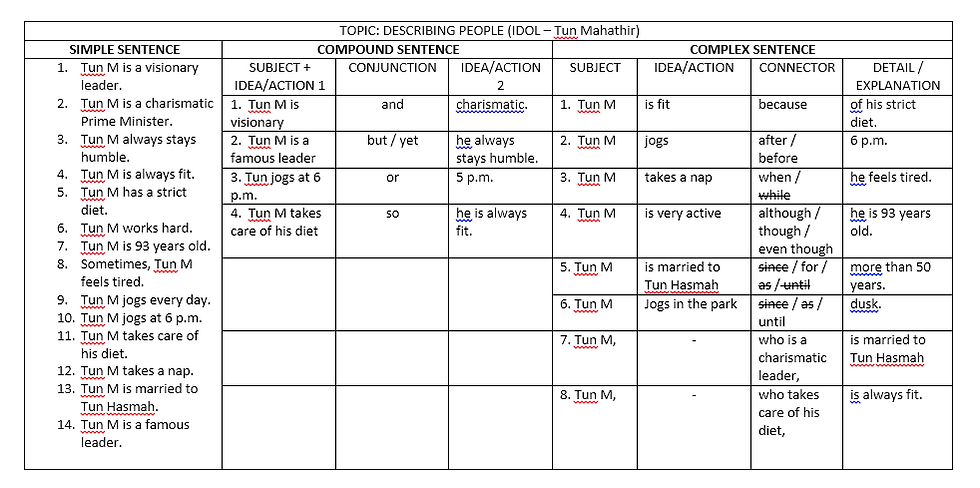Developing Varied Sentence Structures among Intermediate ESL Writers through e-CoR
- Zanurin bin Mohamad Safar
- Dec 21, 2018
- 4 min read
A common weakness in writing is the lack of varied sentences. Yet, having varied sentence structures is always one of the crucial requirements in any writing assessment criteria endorsed by the Malaysian Examination Syndicate. Becoming aware of the three types of sentences; simple, compound, and complex can help intermediate learners vary sentences in their writing.
This write-up attempts to share e-CoR, a strategy to promote clear understanding and mastery of varied sentence structures among intermediate learners who are also generally potential candidates for grade A or B. e-CoR stands for 'Explanation', 'Construction' and 'Repetition'. I do not intend to explain in detail what simple, compound and complex sentences are all about as ESL teachers are fully aware of those explanations and sample sentences. Whatever it is, it is imperative that learners are explained about the simple, compound and complex sentences. They must understand clearly the differences among those sentences before they proceed to sentence construction practices.
The implementation of e-CoR has three main steps. These are further details of how I attempt to develop my learners’ mastery of simple, compound and complex sentences:
Step 1: Explanation
Teacher explains about simple, compound and complex. Learners must know the differences of each sentence types.
Note: In explaining about the descriptions of each sentence, I try to avoid using grammatical terms such as “dependent clause”, “independent clause” and “subordinate ideas”. I feel those terms may scare some of them. Instead, I use simpler ordinary terms and focus more on their clear understanding of what each sentence type is all about.
Step 2: Construction
Teacher gives a topic, for example, Tun Mahathir.
Each learner in the class has to construct one simple sentence based on the topic given; e.g. Tun Mahathir (Refer to Table 1).
[endif]Teacher asks some learners to write their simple sentences on the white board. Perhaps, there should be 7-15 simple sentences about Tun Mahathir.
Teacher and learners check the accuracy of the selected sentences.
Step 3: Repetition
[endif]Teacher shows how the simple sentences or the ideas about Tun Mahathir can be repeated; recycled; used repeatedly to construct compound sentences (Refer to Table 1).
[endif]Teacher reminds learners about the conjunctions “and, but/yet, or, so” that are used to construct compound sentences.
Note: “For” can also be used in making compound sentences, however, I purposely exclude it. I do not want to confuse my intermediate learners as “for” can also be used to construct complex sentences. Therefore, “For” is only used in the Complex Sentence section.
[endif]Then, teacher demonstrates how the simple sentences made by learners can also be used; repeated; recycled to construct complex sentences (Refer to Table 1).
[endif]Teacher revises the descriptions of a complex sentence, if necessary.
Teacher highlights conjunctions / connectors that can be used e.g. while, after, although.
[endif]Teacher guides learners to construct complex sentences, if necessary.

Table 1: Tun Mahathir
At the early stage of sentence construction practices, surely, most of our intermediate learners need guidance from us. Providing them with more sample sentences such as in Table 2, Table 3, Table 4, Table 5 and Table 6 below really enhances their understanding of the simple, compound and complex sentences.
Later, our intermediate learners should be encouraged to be on their own. There should be less dependency on the teacher. Collaborative sentence construction practices should be promoted. Learners must assist each other to construct the three types of sentences. Peer correction is also a very relevant strategy at this stage. Then, when our learners are ready, the construction of simple, compound and complex sentences must be done individually. Whatever they do, the concept of e-CoR is always applicable; learners make a quick revision; they explain the differences of simple, compound and complex sentences, construct simple sentences and then repeat or reuse the simple sentences or the previous ideas to construct compound and complex sentences.
At the end of the day, our intermediate learners will have a better grasp of simple, compound and complex sentences. With sufficient practices, no doubt, they will be able to write varied sentence structures as required by the Malaysian Examination Syndicate.
[Note: I focus on the descriptions of people, events/activities and places in the sentence construction practices. This is due to the fact that I am dealing with INTERMEDIATE learners whose level of English proficiency is obviously not high. However, after a series of repetition on the simple, compound and complex structures, my learners get more familiar with the sentence patterns. Moreover, it is advisable to focus on these three aspects as they are very relevant to essay writing done by the learners. Having those focused aspects really helps learners who always prefer to write descriptive or narrative essays.]
To conclude, e-CoR is just an option. Surely there are various ways to teach simple, compound and complex sentences. Maybe you do have a more effective way. Perhaps, my way has flaws too. However, based on my experience, most of my intermediate learners are able to construct those sentences after several ongoing lessons. The objectives are achieved; learners are able to explain about simple, compound and complex sentences; to construct accurate simple, compound and complex sentences. As for me, I have done what I must do to develop my learners' ability to write varied sentence structures. Of course, there are still rooms for improvements and, in shaa Allah, I will try to address each of the flaws. That matters!

Table 2: Siti

Table 3: Picnic

Table 4: Teacher's Day

Table 5: Mall

Table 6: Resort












































Comments